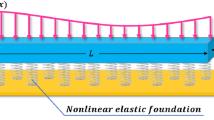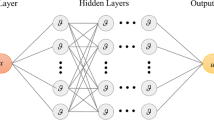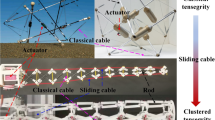Abstract
Structural shape monitoring plays a vital role in the structural health monitoring systems. The inverse finite element method (iFEM) has been demonstrated to be a practical method of deformation reconstruction owing to its unique advantages. Current iFEM formulations have been applied to small deformation of structures based on the small-displacement assumption of linear theory. However, this assumption may be inapplicable to some structures with large displacements in practical applications. Therefore, geometric nonlinearity needs to be considered. In this study, to expand the practical utility of iFEM for large displacement monitoring, we propose a nonlinear iFEM algorithm based on a four-node inverse quadrilateral shell element iQS4. Taking the advantage of an iterative iFEM algorithm, a nonlinear response is linearized to compute the geometrically nonlinear deformation reconstruction, like the basic concept of nonlinear FE analysis. Several examples are solved to verify the proposed approach. It is demonstrated that large displacements can be accurately estimated even if the in-situ sensor data includes different levels of randomly generated noise. It is proven that the nonlinear iFEM algorithm provides a more accurate displacement response as compared to the linear iFEM methodology for structures undergoing large displacement. Hence, the proposed approach can be utilized as a viable tool to effectively characterize geometrically nonlinear deformations of structures in real-time applications.















Similar content being viewed by others
Data Availability
All data generated or analyzed during this study are included in this published article.
References
Tessler A. A variational principle for reconstruction of elastic deformations in shear deformable plates and shells. Langley Research Center: National Aeronautics and Space Administration; 2003.
Tessler A, Spangler J L. Inverse FEM for Full-Field Reconstruction of elastic deformations in shear deformable plates and shells. Proceedings of the 2nd European Workshop on Structural Health Monitoring, Munich, Germany, 2004.
Cerracchio P, Gherlone M, Di Sciuva M, et al. A novel approach for displacement and stress monitoring of sandwich structures based on the inverse Finite Element Method. Compos Struct. 2015;127:69–76.
Gherlone M, Cerracchio P, Mattone M, et al. Dynamic shape reconstruction of three-dimensional frame structures using the inverse finite element method. Proceedings of 3rd ECCOMAS Thematic Conference on Computational Methods in Structural Dynamics and Earthquake Engineering, Corfù, Greece, 2011.
Gherlone M, Cerracchio P, Mattone M, et al. Shape sensing of 3D frame structures using an inverse finite element method. Int J Solids Struct. 2012;49(22):3100–12.
Gherlone M, Cerracchio P, et al. Beam shape sensing using inverse finite element method: theory and experimental validation. Proceeding of 8th International Workshop on Structural Health Monitoring, Stanford, CA, 2011.
Gherlone M, Cerracchio P, Mattone M, et al. An inverse finite element method for beam shape sensing: theoretical framework and experimental validation. Smart Mater Struct. 2014;23(4):045027.
Kefal A, Hizir O, Oterkus E. A smart system to determine sensor locations for structural health monitoring of ship structures. Proceedings of the 9th International Workshop on Ship and Marine Hydrodynamics, Glasgow, UK. 2015 p. 26–28.
Kefal A, Oterkus E, Tessler A, et al. A quadrilateral inverse-shell element with drilling degrees of freedom for shape sensing and structural health monitoring. Eng Sci Technol Int J. 2016;19(3):1299–313.
Li M Y, Kefal A, Cerik B, et al. Structural health monitoring of submarine pressure hull using inverse finite element method. Trends in the Analysis and Design of Marine Structures, 2019: p. 293-302.
Kefal A, Oterkus E. Displacement and stress monitoring of a Panamax containership using inverse finite element method. Ocean Eng. 2016;119:16–29.
Papa U, Russo S, Lamboglia A, et al. Health structure monitoring for the design of an innovative UAS fixed wing through inverse finite element method (iFEM). Aerosp Sci Technol. 2017;69:439–48.
De Mooij C, Martinez M, Benedictus R. iFEM benchmark problems for solid elements. Smart Mater Struct. 2019;28(6):065003.
Kefal A. An efficient curved inverse-shell element for shape sensing and structural health monitoring of cylindrical marine structures. Ocean Eng. 2019;188:106262.
Abdollahzadeh MA, Kefal A, Yildiz M. A comparative and review study on shape and stress sensing of flat/curved shell geometries using C0-continuous family of iFEM elements. Sensors. 2020;20(14):3808.
Wang J, Ren L, You R, et al. Experimental study of pipeline deformation monitoring using the inverse finite element method based on the iBeam3 element. Measurement. 2021;184:109881.
Esposito M, Gherlone M. Composite wing box deformed-shape reconstruction based on measured strains: optimization and comparison of existing approaches. Aerosp Sci Technol. 2020;99:105758.
Gherlone M, Cerracchio P, Mattone M. Shape sensing methods: Review and experimental comparison on a wing-shaped plate. Prog Aerosp Sci. 2018;99:14–26.
Quach C, Vazquez S, Tessler A, et al. Structural anomaly detection using fiber optic sensors and inverse finite element method. AIAA Guidance, Navigation, and Control Conference and Exhibit. 2005 p. 6357.
Colombo L, et al. Anomaly identification in mechanical structures exploiting the inverse finite element method. Proceedings of the 6th European Conference on Computational Mechanics: Solids, Structures and Coupled Problems, ECCM 2018 and 7th European Conference on Computational Fluid Dynamics, ECFD 2018.
Colombo L, Sbarufatti C, Giglio M. Definition of a load adaptive baseline by inverse finite element method for structural damage identification. Mech Syst Signal Process. 2019;120:584–607.
Colombo L, Oboe D, et al. Shape sensing and damage identification with iFEM on a composite structure subjected to impact damage and non-trivial boundary conditions. Mech Syst Signal Process. 2021;148:107163.
Li MY, Kefal A, et al. Dent damage identification in stiffened cylindrical structures using inverse finite element method. Ocean Eng. 2020;198:106944.
Yang H, Wu Z, Sun P. Strain modal method for damage detection based on iFEM. J Vib Meas Diagn. 2017;37(1):147–52.
Li M, Wu Z, et al. Direct damage index based on inverse finite element method for structural damage identification. Ocean Eng. 2021;221:108545.
Li M, Jia D, et al. Structural damage identification using strain mode differences by the iFEM based on the convolutional neural network (CNN). Mech Syst Signal Process. 2022;165:108289.
Tessler A, Spangler JL. A least-squares variational method for full-field reconstruction of elastic deformations in shear-deformable plates and shells. Comput Methods Appl Mech Eng. 2005;194(2–5):327–39.
Krystian Paczkowski, H.R. Riggs. An Inverse Finite Element Strategy to Recover Full-Field, Large Displacements from Strain Measurements. ASME 2007 26th International Conference on Offshore Mechanics and Arctic Engineering, 2007.
Tessler A, Roy R, Esposito M, et al. Shape sensing of plate and shell structures undergoing large displacements using the inverse finite element method. Shock Vib. 2018;2018:1–8.
Acknowledgements
This research is supported by the National Natural Science Foundation of China (Grant No. 11902253) and the Fundamental Research Funds for the Central Universities of China. The authors are grateful for this support.
Author information
Authors and Affiliations
Contributions
ML was involved in data curation, validation and writing—original draft. DJ performed software. HH and ML were involved in formal analysis. HH was involved in funding acquisition. ZW was involved in supervision. ML, ZW, HH and AK were involved in writing—review & editing.
Corresponding author
Ethics declarations
Conflict of interest
The authors declare that they have no known competing financial interests or personal relationships that could have appeared to influence the work reported in this paper.
Consent to participate
The results of this paper presented clearly, honestly, and without fabrication, falsification or inappropriate data manipulation.
Ethics approval
The submitted manuscript was original and was not published elsewhere in any form or languages. The paper was maintaining integrity of the research and its presentation is helped by following the rules of good scientific practice.
Rights and permissions
Springer Nature or its licensor (e.g. a society or other partner) holds exclusive rights to this article under a publishing agreement with the author(s) or other rightsholder(s); author self-archiving of the accepted manuscript version of this article is solely governed by the terms of such publishing agreement and applicable law.
About this article
Cite this article
Li, M., Jia, D., Huang, H. et al. Geometrically Nonlinear Deformation Reconstruction Based on iQS4 Elements Using a Linearized Iterative iFEM Algorithm. Acta Mech. Solida Sin. 36, 166–180 (2023). https://doi.org/10.1007/s10338-022-00369-6
Received:
Revised:
Accepted:
Published:
Issue Date:
DOI: https://doi.org/10.1007/s10338-022-00369-6




